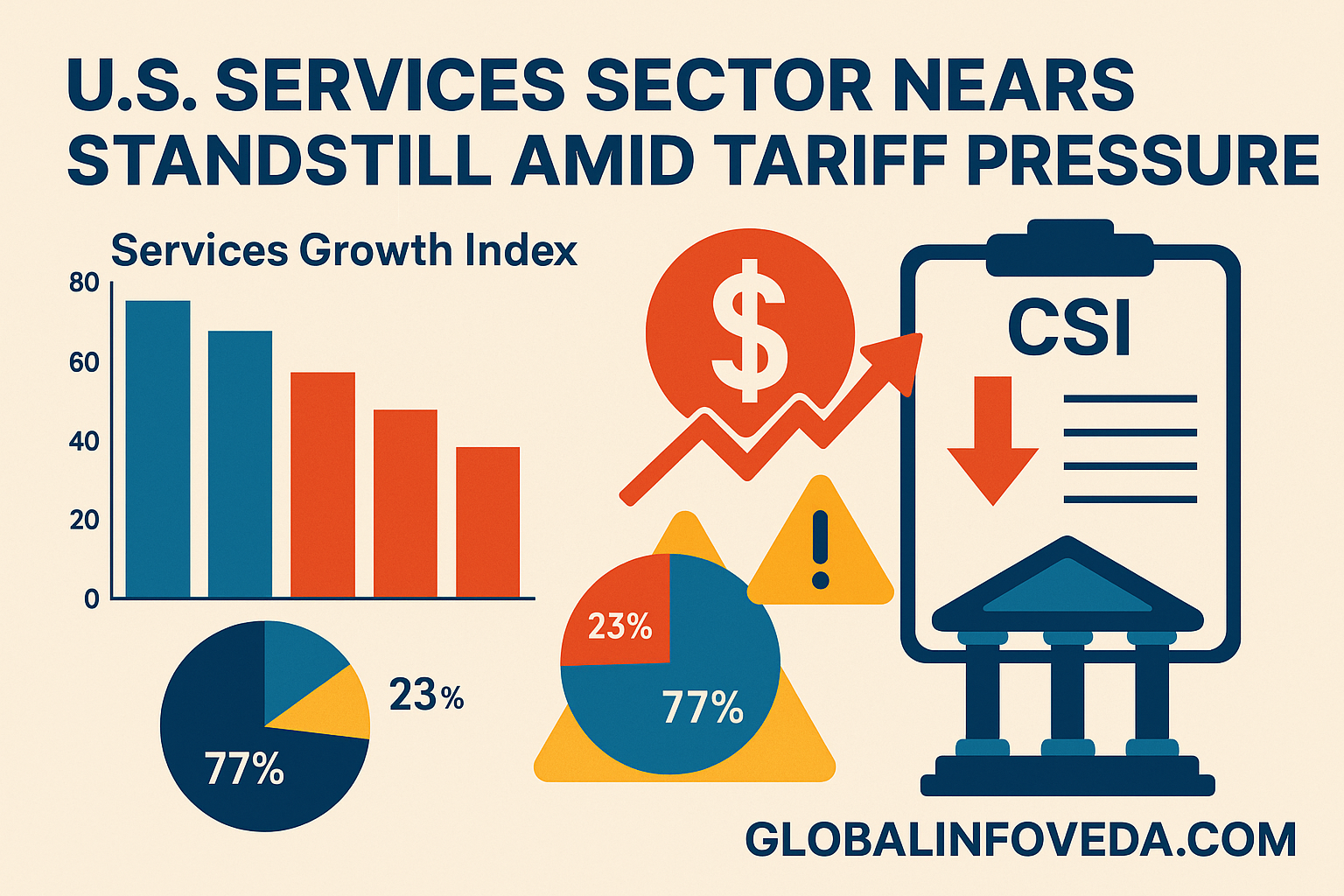U.S. Services Sector Nears Standstill Amid Tariff Pressure
🏛️ Introduction: The Ripple Effect on Services
While tariffs are often linked to manufacturing and goods, their indirect impact is now weighing heavily on the U.S. services sector. From hospitality and logistics to healthcare, education, and professional consulting, service industries are absorbing cost increases from imported goods, raw materials, and equipment. These added costs are slowing investment, compressing margins, and creating operational bottlenecks. The sector that once served as the backbone of U.S. economic growth is edging toward stagnation.
This blog explores the underlying mechanisms driving this slowdown, the most vulnerable sub-sectors, historical parallels, and policy measures that could stabilize the services industry.
📊 Big Picture: Why Tariffs Impact Services Too
- Input Cost Pass-Through: Services rely on goods imports—from restaurants sourcing foreign foods to hospitals acquiring overseas medical devices.
- Consumer Spending Shift: Higher prices for essentials cut discretionary budgets for services.
- Business Investment Retraction: Renovations, expansions, and tech upgrades are delayed as costs rise.
- Eroded Global Competitiveness: Service exporters face retaliatory barriers in foreign markets.
- Interdependent Supply Chains: Delays in goods production disrupt service delivery schedules, raising costs.
📌 In context: Services make up ~77% of GDP and employ over 120 million Americans—any slowdown has macroeconomic consequences.
🔍 Sectoral Exposure: Who’s Most at Risk?
1. Hospitality & Tourism
- Hotels and restaurants pay more for imported foods, beverages, and furnishings.
- Reciprocal visa restrictions reduce inbound tourism.
- Higher prices deter domestic leisure travel.
2. Transportation & Logistics
- Imported parts and maintenance equipment face tariffs.
- Rising fuel costs and delayed imports disrupt schedules.
- Freight rates increase as carriers pass on costs.
3. Healthcare
- Hospitals pay more for imported medical equipment and pharmaceuticals.
- Procurement delays impact care delivery.
- Increased operational expenses risk higher patient bills.
4. Technology & Professional Services
- Tariffs on servers, networking hardware, and office tech inflate overhead.
- Clients cut projects, reducing demand.
- Service exports in consulting, finance, and law face reciprocal trade barriers.
5. Education & Training Services
- Institutions bear higher costs for imported lab gear and educational tools.
- International student flows may shrink under retaliatory policies.
💵 Expanded Economic Impact Analysis
- Slower Job Creation: Hiring freezes in services reduce employment growth.
- Margin Compression: Costs outpace revenue growth, squeezing profits.
- Cross-Sector Feedback Loop: Reduced service demand lowers goods orders.
- GDP Drag: Even 1% slower service growth significantly impacts national GDP.
- Geographic Disparities: Service-heavy metro areas face sharper slowdowns; rural logistics hubs also feel strain.
- Wage Stagnation: Lower service revenues slow wage increases, affecting consumption.
📈 Historical Context
- 2018–2019 Trade Disputes: Logistics, travel, and finance weakened as tariffs reduced trade flows.
- COVID-19 Pandemic: Supply chain blockages froze parts of the services economy.
- 1970s Oil Shocks: Higher transport costs had ripple effects across service sectors.
📊 Tariff Impact vs. Baseline Scenario for Services
| Metric (2025) | With Tariffs | Without Tariffs |
|---|---|---|
| Services Sector Growth | 0.5% | 2.1% |
| Services Employment | +0.3% | +1.5% |
| Service Exports | -1.0% | +0.7% |
| Average Service Prices | +3.4% | +1.8% |
| Wage Growth | +1.2% | +2.4% |
🏛️ Policy & Relief Measures: Keeping Services Moving
1. Targeted Input Exemptions
- Remove tariffs on essential imports for healthcare, hospitality, education, and transport.
2. Investment Incentives
- Offer accelerated depreciation, tax credits, and subsidized loans for service-sector innovation.
3. Export Promotion
- Negotiate service-focused trade pacts to recover market access.
4. Supply Chain Localization
- Incentivize domestic production of high-demand service inputs.
5. Consumer Spending Support
- Expand tax credits and subsidies to maintain household access to essential services.
6. Workforce Development
- Fund upskilling programs to maintain competitiveness despite cost pressures.
🔮 Final Insight: The High Stakes of Service Sector Slowdown
Tariff pressures on the services sector show how deeply intertwined the U.S. economy is. Disruptions that start with goods trade cascade into finance, healthcare, education, tourism, and technology. Without targeted relief and strategic trade policies, the largest employment engine in America could face a prolonged slowdown, affecting both domestic prosperity and global competitiveness.
📡 Stay connected to GlobalInfoVeda.com for ongoing coverage of trade impacts and sectoral resilience strategies.
